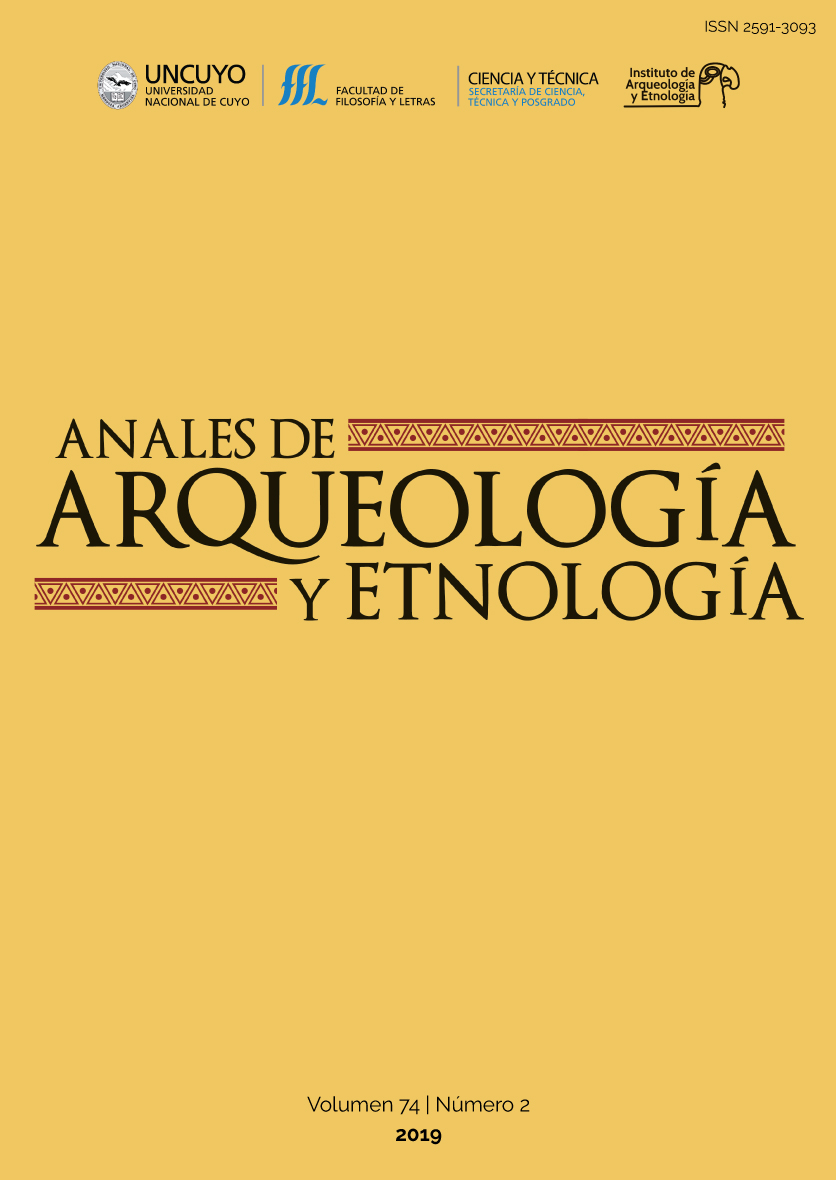Treatment of archaeological information
The example of the database for the Laguna Blanca Archaeological Project (INIP-UNCA)
Keywords:
Database, Data systematization, Archaeological information systemAbstract
The Laguna Blanca Archaeological Project team has been working since 1992 in a region covering 9732 km², and created a large volume of information that has made computer databases (DB) an indispensable tool. Our DB, created in 2015 in Filemaker 12 and currently in Filemaker Pro Advanced 17, is the result of a long process of homogenizing records. This paper proposes efficient tools for systematizing diverse and heterogeneous data produced by archaeological research. The tools make it possible to process and exchange archaeological information and optimize work times and tools. We present the steps in this process, which allows us to manage the current registry of 1227 archaeological sites and 1151 community sites throughout the region, linked to their finds, samples, and graphical and architectural records. We can also generate Unique Records of Archaeological Goods (INAPL) and detailed records of sites and burial contexts. Currently, the interoperability of the DB with Geographic Information Systems (GIS) is under development. The solution we have developed thus covers data management, documentation and cartographic management, and quantitative and interpretative processing.
Downloads
References
Barge, O., X. Rodier, G. Davtian y L. Saligny. 2004. L'utilisation des systèmes d'information géographique appliquée à l'archéologie française. Revue d'Archéométrie 28: 15-24. https://doi.org/10.3406/arsci.2004.1058
Castro, V., F. Maldonado y M. Vásquez. 1993. Arquitectura del ‘Pukara’ de Turi. En Actas del XII Congreso Nacional de Arqueología Chilena, H. Niemeyer (ed.): 79-106. Museo Regional de la Araucanía, Temuco.
Fabra, M., M. Montenegro y M. E. Zabala (eds.). 2015. La Arqueología Pública en Argentina. Historias, tendencias y desafíos en la construcción de un campo disciplinar (1-3). Editorial de la Universidad Nacional de Jujuy.
Courtaud, P. 1996. « Anthropologie de sauvetage »: vers une optimisation des méthodes d'enregistrement. Présentation d'une fiche anthropologique. Bulletins et Mémoires de la Société d'anthropologie de Paris, Nouvelle Série 8 (3-4): 157-167. https://doi.org/10.3406/bmsap.1996.2438
Desachy, B. 2008. De la formalisation du traitement des données stratigraphiques en archéologie de terrain. Tesis de doctorado. Sciences de l’Homme et Société, Université Panthéon-Sorbonne. Paris I. https://tel.archives-ouvertes.fr/tel-00406241v2
Desachy, B. 2017. Le Stratifiant. Application de traitement des données stratigraphiques. Mode d’emploi versions 0.3.5m et 0.3.7– Novembre 2017. https://abp.hypotheses.org/files/2017/12/StratifiantModeEmploi.pdf
Djindjian, F. y B. Desachy. 1990. Sur l'aide au traitement des données stratigraphiques des sites archéologiques. Histoire & Mesure 5 (1-2): 51-88. https://doi.org/10.3406/hism.1990.1365
Djindjian, F. 1993. Les systèmes d’informations en archéologie. Archeologia e calcolatori 4: 9-25.
Figuerero Torres, M. J., F. X. Pereyra, C. P. Movia y L. Cusato. 2013. Archaeological surface visibility: a GIS model for the Lago Posadas Basin, Santa Cruz Province, Southern Patagonia. En Figuerero Torres, M. J. y A. Izeta (eds.) El uso de Sistemas de Información Geográfica (SIG) en la arqueología sudamericana. South American Archaeology Series 18: 73-90. Archaeopress. Oxford.
Gaultier, M. 2017. Une base de données en anthropologie adaptée pour l’archéologie préventive. Usages, enjeux et limites au Service de l’Archéologie du Département d’Indre-et-Loire (Sadil). Bulletins et Mémoires de la Société d'anthropologie de Paris 24: 159-164.
Harris, E. C. 1975. The Stratigraphic Sequence: A Question of Time. World Archaeology 7 (1): 109-121.
Harris E. C. 1979. Principles of Archaeological Stratigraphy. Academic Press. London.
Izeta, A. D. y R. Cattáneo. 2018. ¿Es posible una arqueología digital en Argentina? Un acercamiento desde la práctica. En Humanidades Digitales: Construcciones locales en contextos globales. Actas del I Congreso Internacional de la Asociación Argentina de Humanidades Digitales, G. del Rio Riande, G. Calarco, G. Striker y R. De León (eds.): 75-86. Asociación Argentina de Humanidades Digitales. Buenos Aires.
Lahitte, H., H. Calandra y R. Raffino. 1982. Arquitectura arqueológica. Un modelo para su interpretación. Código para el análisis de los datos. Cuadernos LARDA 2 (3): 1-127.
Léger, C. y L. Ayache. 2017. De la collection d’étude à la collection du musée à Bibracte : état des lieux du système d’enregistrement et perspectives pour la préparation d’un inventaire « Musée de France ». En Inventaire du mobilier archéologique. Actes de la première table ronde du Réseau interprofessionnel des gestionnaires de mobilier archéologique (RIGMA), A. Chaillou, S. Païn y E. Thivet (coords.): 159-172. Presses Universitaires de Franche-Comté. Besançon.
Mousset, F. 2017. L’évolution de l’inventaire normalisé des collections en Lorraine. Ses adaptations au fil du temps (retour d’expérience). En Inventaire du mobilier archéologique. Actes de la première table ronde du Réseau interprofessionnel des gestionnaires de mobilier archéologique (RIGMA), A. Chaillou, S. Païn y E. Thivet (coords.): 17-30. Presses Universitaires de Franche-Comté. Besançon.
Muñoz,G. y J. Trujillo. 2010. New aspects of documentation and recording rock art in Colombia. Session 18 Conservation, Protection and Educational Outgrowths of Recording Rock Art. En Kolber, J. y C. Quijada (eds.) Fumdhamentos IX (III): 931-948.
Païn, S. 2017. Un inventaire de gestion du mobilier archéologique. Questionnements et évolutions dans l’expérience du Service archéologique départemental des Yvelines 1998-2015. En Inventaire du mobilier archéologique. Actes de la première table ronde du Réseau interprofessionnel des gestionnaires de mobilier archéologique (RIGMA), A. Chaillou, S. Païn y E. Thivet (coords.): 31-44. Presses Universitaires de Franche-Comté. Besançon.
Spence, C. 1992. An introduction to the excavation recording system of the Department of Urban Archaeology Museum of London. En Trócoli, I. G. y R. Sospedra (eds.) Harris Matrix. Sistemes de registre en arqueologia 1: 108-253. Pagès Editors. Lleida.
Downloads
Published
How to Cite
Issue
Section
License
Esta obra está bajo licencia internacional Creative Commons Reconocimiento-NoComercial-CompartirIgual 4.0.
Quienes publiquen en Anales de Arqueología y Etnología aceptan las siguientes condiciones:
- Los/as autores/as conservan los derechos de autor y ceden a la revista el derecho de la primera publicación, el cual está sujeto a la licencia Creative Commons, que permite a terceros utilizar lo publicado siempre que mencionen la autoría del trabajo y a la primera publicación en esta revista.
- Los/as autores/as podrán realizar otros acuerdos contractuales no exclusivos para la distribución de la versión del artículo publicado (p. ej., incluirlo en un repositorio institucional o publicarlo en un libro o monografía) siempre que se indique expresamente que el trabajo se publicó por primera vez en esta revista.
Los artículos firmados son de responsabilidad exclusiva de sus autores.
Anales de Arqueología y Etnología garantiza el libre acceso y la gratuidad para autores/as y lectores/as.















